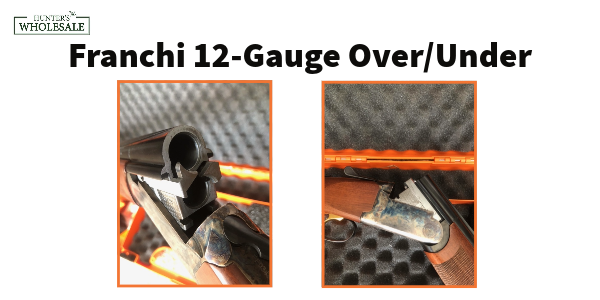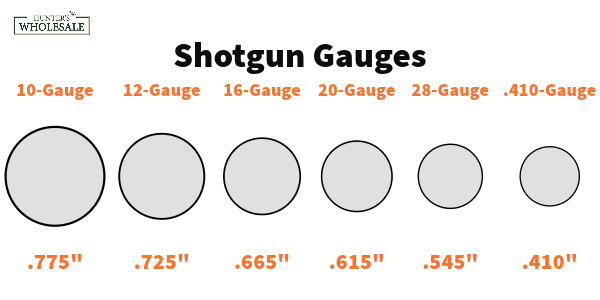You have no items in your shopping cart.
When it comes to the different types of shotguns, not much as changes over the years. Of course, there's some debate when it comes to defining the different types, but in the end it's a pretty simple answer.
For everything related to the types of shotguns, take a look below!
The Different Types Of Shotguns
The different types of shotguns are break-action, semi auto, and pump action.
Break-Action Shotguns
One of the first evolutionary steps in guns began with the invention of the break-action design around the early 1800s.
The break-action name comes from the way the gun is loaded by opening up at the breech. Hunters open the gun by either pushing a locker lever sideways, or a button down. From there, they are able to properly load the gun with their shells.
When it comes to break-action, you'll find several different sub-models including the side-by-side, O/U (over and under), and a single-barrel option.

Pump Action Shotguns
After the break-action came to be, hunters were then given the pump action around the mid-1800s.
Pump action shotguns allow hunters to load more than one or two shells in the adjacent chamber underneath the barrel. After the shells are added through the loading port, they are pumped through the operating cycle and fed into the barrel.
Once shot, the individual repeats the pump motion, pushing the used shell through the exit port and loading a new shell from the chamber.
Semi Auto Shotguns
The most recent adaptation of the shotgun comes in the form of a semi-automatic around the early 1900s.
Similar to the the pump action, semi autos utilize an operating cycle that feeds shells from a storage chamber to the barrel. However, as the name suggests, this is done semi-automatically - not through a pump action.
Semi auto shotguns utilize inertia or gas operation to cycle the action.
Other Types Of Shotguns
Here are a few additional, miscellaneous types of shotguns:
Lever Action Shotguns
One of the least popular types of shotguns is the lever action model.
As the name indicates, these types of shotguns utilize a large metal level behind the trigger - similar to standard "cowboy guns". The lever is pulled down and forward, opening the action, extracting the shell and loading a new one.
Additionally, you might have seen a lever action shotgun in a few scenes from the movie 'Terminator'.
Bolt Action Shotguns
A bolt action .410 is the type of shotgun I grew up on as it's one of the most simple and safe to operate models available on the market.
Similar to your standard bolt action rifle, these shotguns utilize a bolt to load and unload a shell into the barrel. Additionally, bolt action models may or may not come with a standard bottom fed magazine for additional shell storage.
Single Shot Shotguns
Lastly, there's a single shot style of shotgun that utilizes a manual hammer blocking system.
Of course, you might also categorize these as break-action as the breech needs to be opened to successfully load the single shell.
Shotgun Gauges: Every Type
For a full list of the different shotgun gauges, check out the information below:

1. 10-Gauge
The 10 gauge is the largest and most potent shotgun gauge. Primarily used for hunting large waterfowl and turkeys, it's also a good choice for self-defense due to its ability to deliver a substantial payload of shot. However, it's essential to note that the 10 gauge is the heaviest and has the most recoil, making it less ideal for all shooters.
2. 12-Gauge
The 12 gauge is the most common and versatile shotgun gauge. It can be used for a variety of purposes, including hunting, clay target shooting, and self-defense. Available in a wide range of loads, from lightweight target loads to heavy magnum loads, it's suitable for shooters of all skill levels.
3. 16-Gauge
The 16 gauge was once more popular than the 12 gauge but has declined in recent years. It strikes a balance between the 12 gauge and the 20 gauge. Lighter and with less recoil than the 12 gauge, it's still powerful enough for most hunting tasks. A good choice for shooters seeking a versatile shotgun that's easy to carry and shoot.
4. 20-Gauge
The 20 gauge is a popular choice for upland game hunting and clay target shooting. It's also suitable for smaller-framed shooters and those sensitive to recoil. While not as powerful as the 12 gauge, it can still take down most game birds and clay targets effectively.
5. 28-Gauge
The 28 gauge is a small shotgun gauge used for hunting small game and clay target shooting. Extremely lightweight and with minimal recoil, it's an excellent choice for young shooters and those who are recoil-sensitive.
6. .410-Gauge
The .410 bore is the smallest shotgun gauge, typically used for hunting small game and clay target shooting. In some cases, it's used for self-defense. However, it's not as powerful as other shotgun gauges, making it crucial to select the appropriate load for the task.
Shotgun Gauges: Comparison Chart
| Gauge | Bore Diameter (in.) | Typical Uses |
| 10 gauge | .775 | Large waterfowl hunting and turkey hunting. |
| 12 gauge | .725 | All-purpose shotgun for hunting, clay target shooting, and personal defense. |
| 16 gauge | .665 | Upland game hunting, waterfowl hunting, and clay target shooting. |
| 20 gauge | .615 | Upland game hunting, waterfowl hunting, and clay target shooting. |
| 28 gauge | .545 | Small game hunting and clay target shooting. |
| .410 gauge | .410 | Small game hunting, clay target shooting, and self-defense. |
Shotgun FAQs
1. What Are The 4 Types Of Shotguns?
Some hunters consider there to be four main types of shotguns: Over/Under, Double Barrel (Side-by-Side), Semi Auto, and Pump.
2. What Are The Three Types Of Shotguns?
The three main types of shotguns are Break Action, Semi Automatic, and Pump.
3. Which Is Better 12 or 20 Gauge Shotgun?
A 12-gauge shotgun is going to be the best and most versatile gauge available for any type of hunter.
For this reason, I would recommend a 12-gauge unless you really want to sacrifice a little power for less recoil.
4. How Many Shotgun Types Are There?
When you really break it down, there are six types of shotguns: Break Action, Semi Auto, Pump, Lever Action, Bolt Action, and Single Shot.
5. What Is The Best Type Of Shotgun For Hunting?
The best type of shotgun for hunting is going to be a 12-gauge shotgun as it is the most versatile option available to hunters.
As far as the type of shotgun, that really depends on the style of hunting and the individuals preferences. Many upland hunters prefer a break-action over and under, while duck hunters rely heavily upon a semi automatic.
6. Which Shotgun Gauge Is The Most Powerful?
The 10-gauge shotgun is the most powerful gauge on the market because it houses slightly more shot and powder when compared to the 12-gauge.
7. What Is The Weakest Shotgun Gauge?
The .410 is the weakest shotgun gauge as it has the smallest amount of powder grains and shot in each shell, leading to minimal recoil and less shooting power.
8. What Are The Different 12 Gauge Shotgun Types?
The 12 gauge shotgun has several different types including the Over/Under, Double Barrel (Side-by-Side), Semi Auto, and Pump.
Shotgun Type Video Summary
Also, we have a great guide about Shotgun Chokes too!


